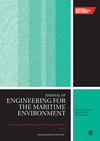Modeling and controlling of ship general section attitude adjustment process based on RBF neural network coupled with sliding mode algorithm
IF 1.5
4区 工程技术
Q3 ENGINEERING, MARINE
Proceedings of the Institution of Mechanical Engineers, Part M: Journal of Engineering for the Maritime Environment
Pub Date : 2024-01-30
DOI:10.1177/14750902241227301
引用次数: 0
Abstract
Due to the advantages such as high efficiency, high precision, and the ability to reduce welding distortion, the block assembly method in shipbuilding possesses currently holds a dominant position in shipbuilding engineering. However, some key issues including low adjustment precision and slow control response speed urgently need to be resolved for the block assembly adjustment technology. This paper committed to solving the problems of inaccurate tracking of target displacement and slow control response speed in the vertical motion axis of the ship block joining equipment. A docking equipment control method based on the RBF neural network coupled with adaptive sliding mode algorithm was proposed. Firstly, an overview of the overall mechanics and control architecture of the ship block joining equipment was provided. Subsequently, a mathematical model for the transmission at the lifting mechanism was established. A sliding mode controller based on position control for the ship block joining equipment was designed for the transmission system. Then, the RBF neural network was employed to adjust the switching gain of the sliding mode controller and develop a self-adaptive sliding mode controller. Finally, simulations and verifications were conducted for multiple sets of input trajectories with different types. The results demonstrated that the combination of the neural network algorithm and the sliding mode control algorithm model presented in this paper reduces the system response time by 28.125% and improves the average motion tracking accuracy by 30.76%.基于 RBF 神经网络和滑模算法的船舶总段姿态调整过程建模与控制
由于具有效率高、精度高、可减少焊接变形等优点,造船中的分块装配方法目前在造船工程中占据主导地位。然而,分块装配调整技术存在调整精度低、控制响应速度慢等亟待解决的关键问题。本文致力于解决船体拼装设备垂直运动轴目标位移跟踪不准确和控制响应速度慢的问题。提出了一种基于 RBF 神经网络和自适应滑模算法的船坞设备控制方法。首先,概述了船块连接设备的整体力学和控制结构。随后,建立了升降机构传动的数学模型。为传动系统设计了基于船体连接设备位置控制的滑动模式控制器。然后,采用 RBF 神经网络调节滑动模式控制器的开关增益,开发出一种自适应滑动模式控制器。最后,对多组不同类型的输入轨迹进行了模拟和验证。结果表明,本文提出的神经网络算法与滑动模式控制算法模型相结合,系统响应时间缩短了 28.125%,平均运动跟踪精度提高了 30.76%。
本文章由计算机程序翻译,如有差异,请以英文原文为准。
求助全文
约1分钟内获得全文
求助全文
来源期刊

CiteScore
3.90
自引率
11.10%
发文量
77
审稿时长
>12 weeks
期刊介绍:
The Journal of Engineering for the Maritime Environment is concerned with the design, production and operation of engineering artefacts for the maritime environment. The journal straddles the traditional boundaries of naval architecture, marine engineering, offshore/ocean engineering, coastal engineering and port engineering.
 求助内容:
求助内容: 应助结果提醒方式:
应助结果提醒方式:


